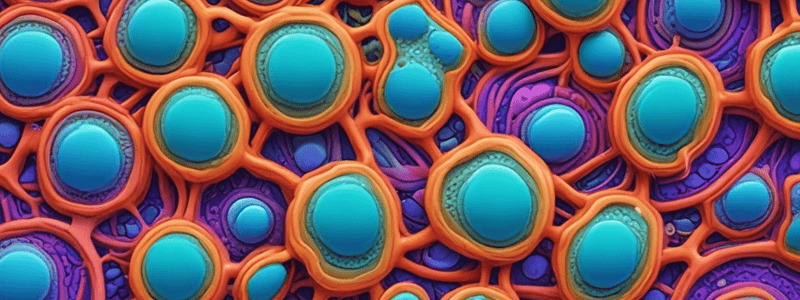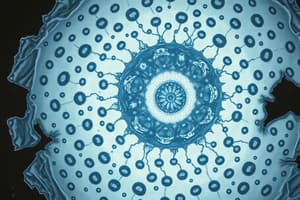Podcast
Questions and Answers
Explain the primary function of the nuclear membrane and nuclear pores.
Explain the primary function of the nuclear membrane and nuclear pores.
The nuclear membrane, a double layer of plasma membrane, and nuclear pores control the passage of material, particularly RNA, in and out of the nucleus.
How do the structures of mitochondria and chloroplasts differ from other cellular organelles?
How do the structures of mitochondria and chloroplasts differ from other cellular organelles?
Mitochondria and chloroplasts have their own DNA and are double-membraned organelles, unlike other organelles.
Describe the process of preparing a plant cell for observation under a light microscope.
Describe the process of preparing a plant cell for observation under a light microscope.
Place the plant cell on a slide with water, cover with a coverslip gently to avoid air bubbles, stain with iodine solution, and focus under low and high power on the microscope stage.
What is the primary role of the cell membrane in maintaining cellular integrity?
What is the primary role of the cell membrane in maintaining cellular integrity?
Explain the relationship between the nucleus and nucleolus in terms of their composition and function.
Explain the relationship between the nucleus and nucleolus in terms of their composition and function.
How does the structure of the cell wall in plant cells differ from that of the cell membrane in animal cells?
How does the structure of the cell wall in plant cells differ from that of the cell membrane in animal cells?
Describe the role of ribosomes in cellular processes and their relationship with other organelles.
Describe the role of ribosomes in cellular processes and their relationship with other organelles.
Explain the significance of vacuoles in plant cells compared to animal cells.
Explain the significance of vacuoles in plant cells compared to animal cells.
What is the primary function of the cell membrane in controlling the passage of chemicals in and out of the cell?
What is the primary function of the cell membrane in controlling the passage of chemicals in and out of the cell?
How do the structures of mitochondria and chloroplasts differ from other cellular organelles?
How do the structures of mitochondria and chloroplasts differ from other cellular organelles?
Explain the significance of vacuoles in plant cells compared to animal cells.
Explain the significance of vacuoles in plant cells compared to animal cells.
Describe the role of ribosomes in cellular processes and their relationship with other organelles.
Describe the role of ribosomes in cellular processes and their relationship with other organelles.
Explain the primary function of the nuclear membrane and nuclear pores.
Explain the primary function of the nuclear membrane and nuclear pores.
How does the structure of the cell wall in plant cells differ from that of the cell membrane in animal cells?
How does the structure of the cell wall in plant cells differ from that of the cell membrane in animal cells?
Describe the process of preparing a plant cell for observation under a light microscope.
Describe the process of preparing a plant cell for observation under a light microscope.
What is the primary role of the cell membrane in maintaining cellular integrity?
What is the primary role of the cell membrane in maintaining cellular integrity?
What is the primary function of the cell membrane in controlling the passage of chemicals in and out of the cell?
What is the primary function of the cell membrane in controlling the passage of chemicals in and out of the cell?
How do the structures of mitochondria and chloroplasts differ from other cellular organelles?
How do the structures of mitochondria and chloroplasts differ from other cellular organelles?
Explain the significance of vacuoles in plant cells compared to animal cells.
Explain the significance of vacuoles in plant cells compared to animal cells.
Describe the role of ribosomes in cellular processes and their relationship with other organelles.
Describe the role of ribosomes in cellular processes and their relationship with other organelles.
Explain the relationship between the nucleus and nucleolus in terms of their composition and function.
Explain the relationship between the nucleus and nucleolus in terms of their composition and function.
Explain the primary function of the nuclear membrane and nuclear pores.
Explain the primary function of the nuclear membrane and nuclear pores.
How does the structure of the cell wall in plant cells differ from that of the cell membrane in animal cells?
How does the structure of the cell wall in plant cells differ from that of the cell membrane in animal cells?
Describe the process of preparing a plant cell for observation under a light microscope.
Describe the process of preparing a plant cell for observation under a light microscope.
What is the primary function of the cell membrane in controlling the passage of chemicals in and out of the cell?
What is the primary function of the cell membrane in controlling the passage of chemicals in and out of the cell?
Describe the role of ribosomes in cellular processes and their relationship with other organelles.
Describe the role of ribosomes in cellular processes and their relationship with other organelles.
Explain the relationship between the nucleus and nucleolus in terms of their composition and function.
Explain the relationship between the nucleus and nucleolus in terms of their composition and function.
How do the structures of mitochondria and chloroplasts differ from other cellular organelles?
How do the structures of mitochondria and chloroplasts differ from other cellular organelles?
Explain the primary function of the nuclear membrane and nuclear pores.
Explain the primary function of the nuclear membrane and nuclear pores.
Explain the significance of vacuoles in plant cells compared to animal cells.
Explain the significance of vacuoles in plant cells compared to animal cells.
How does the structure of the cell wall in plant cells differ from that of the cell membrane in animal cells?
How does the structure of the cell wall in plant cells differ from that of the cell membrane in animal cells?
Describe the process of preparing a plant cell for observation under a light microscope.
Describe the process of preparing a plant cell for observation under a light microscope.
Flashcards are hidden until you start studying




